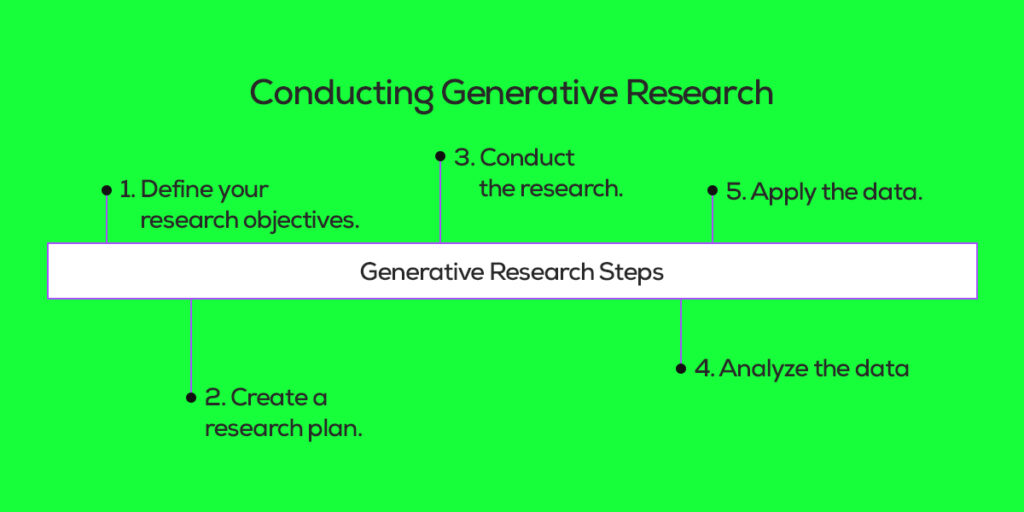Generative research aims to uncover the pain points the users face that were previously unknown to the business hence bringing fresh insights to develop a USP for your brand.
Generative research is a relatively new concept, which gives a fresh perspective to the way research is done and has been widely adopted by marketers. But what is it exactly? This blog will give you a detailed understanding of what generative research is and what are the various methods to do it.
What is Generative Research

Did you know, a report presented at CCC suggests that 91% of customers will not leave feedback or complain if they encounter a bad experience with a brand? They will simply switch over to a competitor. Hence, understanding your users through an elaborate research strategy is crucial.
Generative research is focused on developing a more profound understanding of your users and identifying the problem you will address during the design thinking process. Generative UX research aids in producing ideas that provide guidance for the rest of your work. It is often conducted through qualitative methods such as interviews, focus groups, or observation.

It is usually discovery or exploratory in nature and is often used to generate hypotheses or to develop new theories. Generative user research is a powerful research method that helps generate a deeper understanding of people’s motivations, pain points, behaviors, and more. This type of research is important because it allows companies to get an insight into their target audience so they can create products or services that cater to their needs. Additionally, generative research can also help businesses develop new ideas by getting feedback from consumers about what they want to see.
How to Perform Generative Research

Define your Project Goals

Generative design research is a type of investigation that’s geared towards uncovering unknown issues instead of starting with a pre-existing problem as other types of research do. To do this, begin by setting some objectives that you want to achieve through this process. This could involve figuring out who your target customer is, understanding user lifestyles, or pinpointing pain points that are associated with one of your products. You might not know what challenges exist until you conduct this type of research, so it’s important to go into it with an open mind and be prepared to explore whatever unknowns come to light.
Create your Research Plan

When embarking on generative research, it is important to have a clear and concise research plan. This plan should outline the goals of the research, the methods to be used, and the timeline for completion. Additionally, the research plan should identify the individuals who will be involved in the research process and their respective roles. By having a well-defined research plan, you can ensure that your generative research will be carried out effectively and efficiently.
Conduct the Research

How you proceed with conducting research is essential to acquiring accurate and helpful information. Will you use interviews, focus groups, or surveys? This data can be used to generate new ideas and insights about a product or service. Your research plan is your guide to conducting your study – so use it! Get in touch with your participants to get the process started. By sticking to your plan, you’ll be able to collect high-quality data that will be helpful in answering your research questions.
Analyze the Data

After you’ve completed your research, spend some time organizing and studying the data you’ve collected. It’s time to start delving into it to look for answers to the research questions you formulated at the start of your project. This will help you better understand your findings and see any patterns that may have emerged.
Present the Results
It is essential to present your research findings in a format that is easy to understand and has clear points that can be acted upon. By presenting your findings at a conference, you can reach a large audience of experts in your field and get feedback that can help improve your work. Alternatively, you can choose to publish your results in a journal or online, which will allow others to easily access and read your work. Use the information you have gathered to start creating solutions for common issues that your target market experiences. Once you have a few solutions, you can start testing them in the marketplace to see which ones work best.
Generative Research Questions
There are a few key generative UX research questions that you should always ask yourself before or while conducting the research in order to get the most useful information possible.
- Should we consider only active customers or new customers as well?
- Based on the insights from this research project, what decisions are you trying to make?
- How did you handle this problem? What were your successes and failures?
- In what ways does this data affect my clients?
- Which research method will we use for this project?
- Are you at the beginning or end of the product development process?
- How would you like the outcome to be?
- Is there an ideal solution to this problem?
- Does this problem affect anyone else?
- In what ways are we hoping to impact KPIs?
Generative Research Methods
Much like other types of research, one can plan to achieve results using different generative research techniques. Depending on the goal you aim to reach, you can choose from the following research methodologies.
- Field Studies
- User Interviews
- Ethnography
- Focus Groups
- Diary Studies
Keep reading to know more about each of these generative user research methods.

Field Studies

As Jakob Nielson says, “Pay attention to what users do, not what they say.” Field studies allow you to do just that.
Field studies are a type of generative UX research method that involves observing and interacting with people in their natural environment. This type of research is often used in order to better understand human behavior and social interactions. Field studies can be used to generate new ideas or to help researchers better understand a particular phenomenon. Field studies are beneficial because they provide insights that cannot be gathered in an office or lab setting.
User Interviews

User interviews are a powerful generative research methodology for uncovering user needs and requirements. They can be used to generate new ideas and insights and to validate existing assumptions.
User interviews are typically conducted one-on-one, in a natural setting such as the user’s home or workplace. This allows for a more informal conversation, which can help to uncover hidden assumptions and uncover new insights. User interviews can be used at any stage of the design process, from generating initial ideas to evaluating final designs.
Ethnography

Ethnographers seek to understand the cultures and social systems of the people they study, and their work often results in detailed descriptions and insights into the way these cultures and systems operate. Ethnography can be an extremely effective research technique for understanding complex social phenomena. It allows researchers to generate new insights and perspectives on the people and cultures they study and can provide a rich and detailed understanding of the way these cultures operate.
Focus Groups
Focus groups are a type of generative user research that can be used to generate new ideas and insights. They involve bringing a group of people together to discuss a topic or issue and can be an effective way to explore new ideas and produce new insights. When conducting focus groups, it is important to ensure that the group is diverse in terms of age, gender, race, ethnicity, and background. This will help to ensure that a wide range of perspectives is represented and that the discussion is rich and fruitful.
Diary Studies

Diary studies are a type of research method in which participants keep track of their thoughts, experiences, and behaviors over a period of time. This type of data collection can provide insights into how people think and behave on a daily basis, which can be difficult to capture through other methods. Diary studies can be used to bring in new ideas and hypotheses about behavior, as well as to test and refine existing theories. They can also be used to evaluate interventions or treatments, by observing how people’s behavior changes over time in response to the intervention. Diary studies require participants to be highly engaged and motivated, as they need to maintain a regular record-keeping practice over an extended period of time.
Generative Research vs Evaluative Research
Generative research is focused on generating new knowledge or creating new theories. Evaluative research, on the other hand, is focused on assessing the effectiveness of something that already exists.
Generative design research is often exploratory and is conducted to generate new ideas or hypotheses. This type of research is often used in the early stages of a project when there is little known about the topic. Evaluative research, on the other hand, is used to assess the effectiveness of something that already exists. This type of research is often used in the later stages of a project when there is more information known about the topic.
Both types of research are important in the UX design research process. A generative approach to research is important for producing new ideas and hypotheses, while an evaluative approach to research is important for assessing the effectiveness of something that already exists.
Generative UX research is the process of designing a product from the ground up using a combination of market research, product research, and even user behavioral research. Some of the best products in the world were developed using generative design research. We hope that you have found this guide useful and that you have a better understanding of what generative research is, how to do it, and why it is important for any business to conduct it.
In brief, here is how generative research is different from other research methods.
Evaluative vs Generative Research
| Generative Research | Evaluative Research |
| Explores newer possibilities for the product. | Evaluate and analyze pre-existing products. |
Formative vs Generative Research
| Formative Research | Generative Research |
| Focuses on testing hypotheses. | Focuses on identifying new hypotheses. |
Formative Research vs Evaluative Research
| Formative Research | Evaluative Research |
| Brings results on what can be used to design products. | Analyzes products to understand what needs to be changed. |
FAQS on What is Generative Research
Why is generative research important?
Generative research is important because it helps us to understand the world around us. It allows us to generate new knowledge and to test existing theories. Generative research is also important because it allows us to build upon what we already know. For example, if we want to understand how a new technology works, we can use generative research to create a model of that technology and test our hypotheses about how it works.
How do you start generative UX research?
Define the research question or problem and develop a research plan, identify potential sources of data, including primary data sources (e.g., interviews, surveys, observation) and secondary data sources (e.g., existing data sets, literature review), develop data collection protocols and tools, and collect data, analyze the data and develop findings, write up the findings and present the research.
What is a generative user research example?
There are many methods for conducting generative user research, including ethnography, contextual interviews, focus groups, and data mining.
How do you define generative research?
The generative research definition may go as follows, “Generative research is a research methodology that allows the researcher to understand the users and their problems to identify gaps in the product that can be filled to improve and innovate the product quality.”
Conclusion
Researching your audience before you invest in your product is crucial to ensure that the product is successful when it hits the market. Generative research helps you find and identify the gaps in your product and its design that you may not have realized before. This enables you to get an edge over your competitors as you modify the product to suit your audiences better.
In this article, we discussed what generative research is, its types, and how you can conduct it before designing your product.
How Can Yellow Slice Help 🚀
The UX research team at Yellow Slice is adept at helping our clients understand their audience. We offer consultations and create research strategies that align with your goals to help you get rich data-driven insights. Using these, you can make informed decisions about the designs and functionalities of your product.
Want to know how our UI/UX design solutions can help your brand? Send us a message to get a quick consultation call from us.




